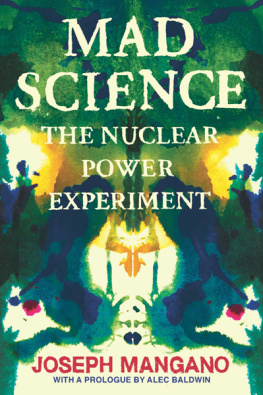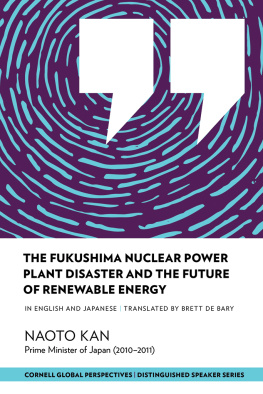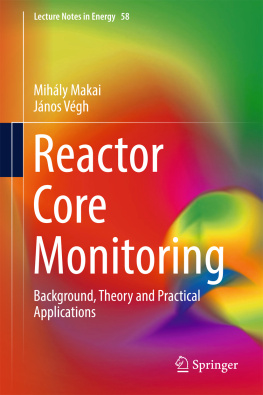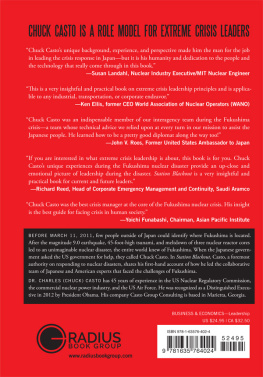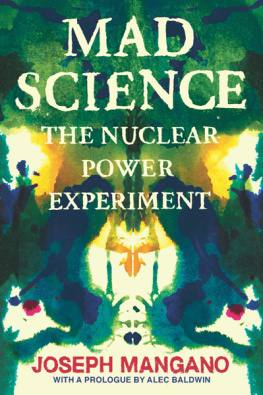

2012 Joseph Mangano
Published by OR Books, New York and London
Visit our website at www.orbooks.com
First printing 2012
All rights reserved. No part of this book may be reproduced or transmitted in any form or by any means, electronic or mechanical, including photocopy, recording, or any information storage retrieval system, without permission in writing from the publisher, except brief passages for review purposes.
Cataloging-in-Publication data is available from the Library of Congress.
A catalog record for this book is available from the British Library.
ISBN 978-1-935928-85-0 paperback
ISBN 978-1-935928-86-7 e-book
Typeset by Lapiz Digital, Chennai, India.
Printed by BookMobile in the United States and CPI Books Ltd in the United Kingdom.
The U.S. printed edition of this book comes on Forest Stewardship Council-certified, 30% recycled paper. The printer, BookMobile, is 100% wind-powered.
Prologue
I grew up in a household with five siblings, and my father was a schoolteacher back in the 1960s and 70s.
I remember my mother, who seemed to fret over money issues at every moment, would stress out about our utility bill. During the winter, she turned the heat down to fifty-five at night and was constantly admonishing us to turn off the lights. After sunset, the lights were on in our house on an as needed basis. We had to use power carefully, and in an age of fewer electronic gizmos and demands on power that we live with today. Most homes had one television. No VCR, no Xbox, no computers, no cell phones. My mother whined over any electric bill higher than thirty dollars. From the beginning, energy meant cost.
So companies schemed about how to lower that cost. Nuclear power was presented, not as an answer, but as the answer. On Long Island, in the early 1970s, the power authority, the Long Island Lighting Company (LILCO), joined the tide of utilities that were applying for and constructing nuclear reactors in order to address the countrys dwindling domestic oil production and a looming US dependence on foreign oil. The Shoreham Nuclear Power Plant was started in 1973 and LILCO proposed that it would cost $75 million. By the time it was completed, in 1984, the cost to build the facility, which would be passed on to LILCO ratepayers (who were already paying among the highest rates in the continental US), was $2 billion.
In addition to the mismanagement and usurious rates that were to be borne by Long Islanders, Shoreham was deemed inoperable due to an ineffective evacuation plan that would have forced Long Islands large, residential population to bottleneck through New York City area roads, tunnels, and bridges in case of a catastrophic event involving the reactor. In 1989, Shoreham was closed in an agreement with New York State officials that passed on nearly all of the then-$6 billion cost of closing, decommissioning, and decontaminating the facility on to LILCO customers, who then officially became the highest commercial utility ratepayers in US history.
The numbing debacle that is the story of Shoreham, and the nearly criminal enterprise that launched it (exiting LILCO executives paid themselves multimillion dollar bonuses in the wake of the fiasco), presents only one side of the sad and demoralizing history of the nuclear power industry that I have come to know over the past twenty years. Over time, I became involved with other community organizations in applying the Shoreham Principle to the closing of the research reactor at Brookhaven Lab. My association with various public interest groups has introduced me to rhabdomyosarcoma clusters near where I live, the arrogant and oft-penalized management of the Millstone nuclear facility in Waterford, CT (the recipient of the largest government fine in history: $2.1 million), and I learned about the Oyster Creek facility in Toms River, New Jersey, where soft tissue cancers and autism rates are significantly higher than the national average.
Along the way, I have met many concerned and dedicated activists as well as scientists. Dr. Ernest Sternglass, Dr. Helen Caldicott, Jay Gould, Scott Cullen, Richard Webster, just to mention a few. My neighbor Christie Brinkley did yeomans work on the Oyster Creek public information programs that we worked on. However, the real thread in all of this, the constant, tireless voice that has helped keep me linked to reports from the front lines of the battle to expose the staggering risks to public health posed by nuclear power, has been Joe Mangano.
Ill let Joe give you the facts and his analysis of them. I simply want to state that Joe has been one of the most dedicated, intelligent, and evenhanded public activists I have ever known. He has also proven to be one of the most effective, on a battlefield where gains are measured in inches, if not centimeters. If not for Joes efforts, as well as those of quite a few other concerned citizens, Oyster Creek might have remained open indefinitely, spewing its special cocktail of nuclear byproduct all over the Ocean County, New Jersey community and adding more to the stockpile of waste that we still dont know what to do with. As of now, the plant is scheduled to close in 2019, ten years earlier than its operator, Exelon, had originally sought in its extension applications. Part of that is Joe.
Read this book and learn in a few hours what it took me years to cobble together from knowing this great public servant.
Alec Baldwin
New York City
April, 2012
Nuclears Rise and Fall
On a warm California morning July 12, 1959 just outside Los Angeles, workers at the experimental nuclear reactors at the Santa Susana Field Laboratory reported for duty. Those who worked on the Sodium Reactor Experiment, one of ten reactors at the lab, were eager to make the fourteenth in a series of tests of the futuristic machine. The experiment tried to cool uranium fuel in the reactor core with sodium rather than the standard method, which used water. Hopes were high that this design would revolutionize atomic power reactors in the US, and perhaps around the world.
There had been problems with the first thirteen tests over the past two years. In the most recent one, there had been an explosion. The inexperienced workers tried to find its cause, but were unsuccessful. In retrospect, leaks had probably limited the ability to keep the sodium cool a crucial aspect of running the reactor safely. But instead of taking the prudent path of stopping or postponing the test series, Test 14 was placed right on schedule, with no delays.
Almost immediately after work began, something went badly wrong. The sodium was not cooling the reactor core, which heated up to levels never seen before at Santa Susana or perhaps in the US. Inside the core were long rods, containing uranium atoms that were split to power the reactor, along with the dozens of dangerous radioactive chemicals formed as waste products when uranium atoms are split. The long rods began to melt, and a large volume of radioactive gas built up in the reactor room. Instead of shutting down the reactor and investigating the cause, technicians added additional rods designed to control the process, but these only made the situation worse.
The next two weeks were a series of restarts and more meltdowns, similar to repeatedly banging ones head against a brick wall. Why didnt managers shutdown the Sodium Reactor Experiment? The answer was one common to the US atomic power program: adherence to a mentality of the show must go on in spite of any dangers. Every day, radioactive gases from holding tanks in the reactor building were released into the air often at night, a highly toxic job given to workers on the graveyard shift. Finally, two weeks to the day after the run started, the reactor was finally shut down. The amount of radiation released into the environment was never accurately measured in fact the entire meltdown was kept secret from the public for the next two decades. Sodium-cooled reactors failed; of the 439 reactors operating worldwide today, only two are sodium cooled (none in the US). But the damage had been done, and today the Santa Susana site sits amidst a large mess of toxic waste.
Next page
